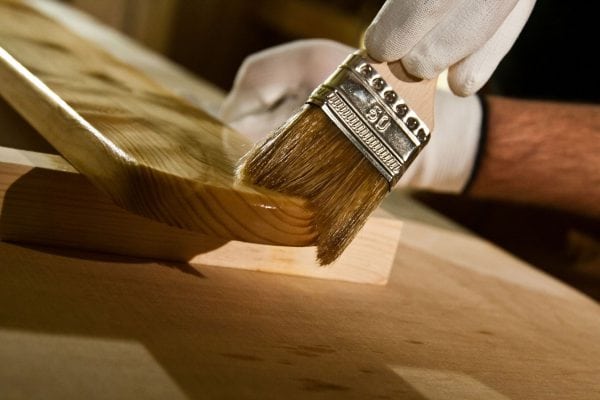Currently, antiseptic varnish is used to decorate wooden facades and conduct interior work. This paint and varnish material is mainly used for decorating wooden products, as due to its properties, it is able to protect the tree from damage from fungi, mold and does not allow its blueness. Thus, when staining with this type of varnish, the furniture acquires natural beauty that pleases the eye.
- The main characteristics of antiseptic varnish
- Staining technique
- Rules for surface use
- Safety Instructions for Use

Such wooden materials as lining, boards, timber and many other elements inside and outside the premises can be coated with antiseptic varnish. Another impregnating varnish with an antiseptic effect is used when tinting wooden floors with their further coating with parquet varnishes diluted with water.
Also, this impregnating because of its wax structure has a water-repellent effect. As a result of this, all surfaces painted with an antiseptic varnish coating will be protected from exposure to water, microorganisms and discoloration.
to contents ↑The main characteristics of antiseptic varnish
| Color spectrum | Colorless |
|---|---|
| The main purpose | Used for indoor and outdoor use |
| Surface Material | Tree |
| Appearance of the surface after staining | Glossy Silky Shine |
| The cost of applying one layer when working with planed wood surface | 12-15 m2 / l |
| The cost of applying one layer when working with a sawn wood surface | 5-10 m2 / l |
| Standard filling of paintwork material | 9 liters |
| Density | 1,0 kg / l |
| Solids percentage | 18% |
| Type of diluent | Water |
| Optimum ambient temperature for application | +5 to +28 degrees |
| Sustainability options | Resistance to aggressive chemicals and washing |
| Application Method | Using a sponge, brush or spray |
Conditions to be observed when processing wood materials with antiseptic varnish:
- Mandatory presence of a dry and clean surface that they are going to paint.
- The temperature of air, varnish and wood coating during painting should not be less than +5 degrees.
- Relative humidity should not rise above 80%.
- The surface on which this type of varnish is going to be applied must be pre-treated. It must be sanded in advance and cleaned of possible contaminants. A prerequisite is the removal of dust from grinding.
- Facade elements are pre-stained with the Sanatex antiseptic. The instructions for using this product must be strictly followed.
- Old paintwork is removed with a scraper.
Staining technique
Before starting work, you need to shake the jar with varnish and mix its contents. We should not forget about this during the paintwork, as periodic stirring contributes to an even distribution of particles and pigments of the paint composition.
Experts recommend applying varnish in 1-2 layers, and when painting furniture indoors and outdoors, apply 3 layers. Basically, people who have extensive experience with this composition, apply it with a roller, brush, sponge or spray method.
Dyeing is carried out in the direction of the fibers of the wood material.After the first layer has been applied, the working surface is ground in order to remove the fibers of the rising tree. All colors produced by the manufacturer can be mixed with each other or even lightened with a colorless antiseptic varnish.
The final color of the surface to be painted depends on factors such as the initial shade of the wood coating, wood species and of course, on the number of layers applied. When painting a large surface area, it is recommended to mix the required amount of antiseptic varnish in one container to ensure a uniform shade.
Rules for surface use
There are special rules for caring for a surface that has been painted with this method. You should not use detergents and it is advisable to avoid intensive cleaning of the just painted surface. This is due to the fact that a fresh painted surface on a wooden base finally hardens and acquires resistance only after two weeks after the work has been completed.
In order not to harm the coating during cleaning with wet cleaning, use a soft and light cloth. Neutral detergents are allowed to clean the coating only after a month.
You need to do this with a sponge or any soft cloth. Then you need to diligently wash with clean water the entire painted wooden surface.
After completing all work, the tools that were used during painting should be cleaned with alcohol solutions so that particles of paintwork do not settle on them.
to contents ↑Safety Instructions for Use
During the work on painting wood with this varnish adhere to certain rules on labor protection. This acrylic antiseptic is fire and explosion proof, making it an ideal option for domestic use. It also has no unpleasant odor.
Antiseptic acrylic varnish does not need to be mixed with other paints and solvents. This composition should not be allowed to come into contact with the eyes and skin, but if this happens, rinse them immediately with cold water and seek medical help from specialists.
People who perform work with antiseptic varnish must be wearing rubber gloves, as getting it on the skin of the hands can cause allergic reactions.
Indoor painting is carried out only with sufficient ventilation so as not to breathe in pairs of antiseptic varnish.
Modern varnish antiseptic for wood helps protect wooden surfaces from the harmful effects of microorganisms, fungi and mold. As a result, the tree retains its characteristics and aesthetic appearance for longer.







